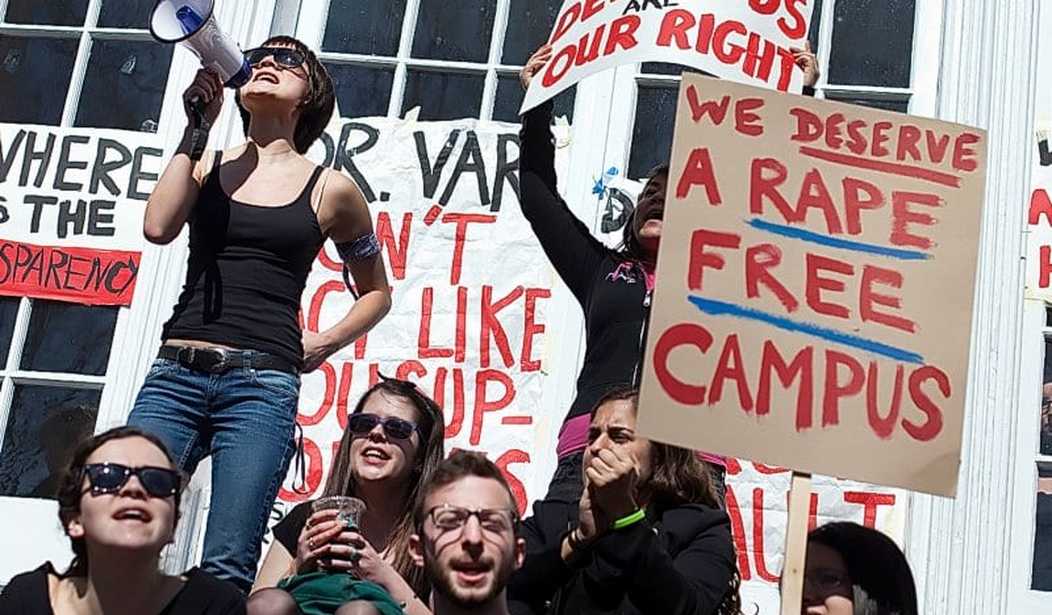College rape has become a national scandal. We are constantly informed that female students live in peril of being sexually assaulted in proportions that defy statistical credibility. Recently, for example, Andrea Horwath, Ontario NDP leader, claimed on national television that the university is a dangerous place since one in three female students will be sexually assaulted. No crime on the planet has such a victimization rate which, if true, would require something approaching martial law to redress.
In any event, the NDP leader is bravely confronting the danger as she visits various campuses prior to the provincial elections. Andrea, however, judging from a recent appearance on CBC TV, is safe.
Thanks to such unseemly advocates and their emasculated brethren (who proliferate in the political, academic and legal professions from which their careers or ideological agendas materially advance), the rape meme has spread throughout the U.S. and Canada with bubonic rapidity. The real victims of the plague, however, are not female students but circumstantial evidence and common sense.
Let’s consider. What responsible parent would send his or her daughter to university if she stood a 33% chance of being sexually assaulted and her life potentially ruined? Or would not labor to find an institution where she might conceivably emerge unscathed from her studies? And why, for that matter, would female students now outnumber their male counterparts by a significant number and graduate in greater numbers as well, which MIT economists David Autor and Melanie Wasserman in their 2013 study, The Emerging Gender Gap in Labor Markets and Education, call a “tectonic shift” in the educational landscape? The disparity is approximately 60-40 and, in some departments like English, as high as 80-20.
“[T]he gains of women have been nothing less than stunning,” the MIT researchers observe. The same is true of various faculties, especially educational departments and medical school. Any objective and impartial study would reveal that women have done remarkably well while men have been psychologically raped and economically assaulted. No man is safe from unproven or anonymous allegations of sexual assault or from classroom prejudice, which explains the declining numbers of males attending and graduating university. Andrea Horwath is unintentionally right. The campus is indeed a dangerous place — not for women, but for men.
But facts cannot budge a meme. USA Today featured an article noting that 89% of colleges reported zero rapes in 2015. The author Patrick deHahn, however, is having none of it. After all, he argues, “Reported is really the key word. Just because a school had no rape reports doesn’t mean no rapes happened.” In a sense, deHahn is correct: “report” really is a key word, since his article is merely a “report” of a report, which, following the logic applied therein, does not mean that his report needs to be believed or accepted. Logic was never the strong suit for the radical feminist sorority and their male hangers-on, a cadre for whom the under-reporting of rape becomes indisputable proof that indiscriminate campus rape actually exists.
DeHahn then quotes another survey which reports, pro forma, that “more than one in five students said they experienced sexual abuse.” Naturally, it is never made clear precisely what constitutes “sexual abuse.” According to radical feminist Mary Koss, who helped start the accusatory rampage with her articles and books positing a one in four figure, almost anything can constitute sexual abuse: sexual comments, jokes, provocative remarks, pressure.
In The Rape Victim, she enumerates “traumatic experiences” such as “unwanted touching,” “non-consensual voyeurism,” “workplace harassment,” and “ostensibly consensual sexual intercourse subsequent to verbal pressure, threats to end the relationship, or false promises,” among others, all equivalent to sexual assault. Of course, raptorial feints like threats and false promises can work both ways, but Koss cannot admit any form of parity.
Koss then offers the bedazzled reader a tsunami of different categories of rape, to wit: individual rape, pair rape, multiple rape, stranger rape, acquaintance rape, date rape, marital rape, partially planned rape, unplanned rape, reported rape, campus rape, hidden rape and so on — though she neglects to mention the trauma from which she herself evidently suffers, namely, rape on the brain. And of course, in today’s feminist climate, an inebriated woman who has sex is counted as a rape victim; her inebriated male partner is regarded — and prosecuted — as the perpetrator, as the notorious Brock Turner rape case at Stanford made clear. The man always takes advantage of the woman. The woman never takes advantage of the man. According to the feminists, female compliance is almost always a consequence of male coercion.
What is now obvious is that the standard exaggerations simply do not hold. The American College Health Association in its 2017 survey of campus life reported non-consensual sexual penetration among female students at 3%. “Penetration” may not necessarily mean what it implies; intimate touching, caressing or probing is also defined as “penetration.” Of course, this is a survey whose categories are already extremely vague; for example, non-consent is often a retroactive consideration. Days or weeks after a sexual encounter, a woman may feel she had been pressured or “guilted” and therefore did not really consent. She then files a complaint which is accepted literally by campus authorities, since her actual compliance or state of self-induced intoxication is not regarded as a contributing element. After all, yes doesn’t always mean yes.
In its Executive Summary for Spring 2016, the National College Health Assessment for the province of Ontario, where my wife teaches at a major university, assigns a value of 2.6% for its “sexual penetration without their consent” category. At the same time the Academic Impacts section states that only 1.3% of students considered “Assault (sexual)” as affecting their academic performance. In either case, the ratio is not even close to the 33% figure cited by political bloviators like Andrea Horwath.
It gets worse — or better, depending on your viewpoint. The Special Report for 1995-2013 issued by the U.S. Department of Justice actually reduces the rape tally to .6%, that is, from 330 per 1000 as the feminists and social justice types claim to 6.1 per 1000. Still too much, of course, but better less than 1% than over 30%. The problem, too, as we have seen, is that the concept of rape has been stretched so thin as to include even the most normal initiative or innocuous gesture. In this case, the real statistics for college rape victims should probably be pegged at one out of one, or 100%.
One of the most important and enduring books on the subject is Christina Hoff Sommers’ Who Stole Feminism?, published in 1994, in which she analyzes Koss’s unsound approach and advocacy research in the latter’s study of sexual assault. Since Koss holds that rape, as she wrote in her 1985 Ms. Magazine article “The Hidden Rape Victim,” “is on a continuum with normal male behavior,” even fondling or petting may constitute sexual victimization. Further, fully 73% of Koss’s ostensible rape victims did not believe they had been raped, but Koss’s method “allows the surveyor to decide whether a rape occurred,” a very handy modus operandi. The problem is that Koss and her congeners, as Sommers demonstrates, design their questionnaires to yield high numbers. Low figures generate no headlines.
The reputable studies Sommers consults that disarmed the stratospheric numbers of sexually victimized campus females appeared in the early ‘80s, yet in 2018 the inflated calculus is graven in many university brochures and pamphlets. The USA Today article cited above features an image of Stanford students wearing mortarboards marked 1/3. How to explain this anomaly?
For one thing, radical feminists will without compunction use outright lies, dodgy statistics and obscurantist dogma to advance their inflammatory message that American (and Canadian) culture is sexist, misogynist and patriarchal, and that the university is a seething pit of male predation. And students and staff have bitten into the nothingburger. For another, the rape crisis movement is largely a function of privilege. College girls, stemming primarily from middle and upper middle class families, are a comparatively pampered group who are accustomed to or expect favored treatment, even if the threat is practically non-existent; their counterparts in poor areas and blue collar districts, Sommers points out, receive little attention or funding.
Campus rape is an ideological fairy tale, the negative image of genuine fairy tales which, as Faith Moore writes in PJ Media, “have their own symbolic code … to reveal a universal truth,” namely, “the good is beautiful.” The feminist fairy tale teaches the opposite: fear, aggression and hatred — in effect, the beautiful is bad. The handsome prince is a rapist at heart rather than a symbol of beneficial transformation.
I think it is fair to say, following a judicious review of the methodologies in play, the misandrist agenda of the militant feminists and the empirical evidence of the senses, that the feminist data are utterly fraudulent. After listening to the ideologues, the trolls, the man-haters, the snowflakes, the journalists, the counselors, the “experts,” the politicians, the spineless college administrators and the rest of what novelist Thomas Pynchon called “the whole sick crew,” one might be inclined to avail oneself of the new analgesic now on the market for beleaguered parents, but which surely allows for multiple purposes and applications. Just ask the pharmacist for a bottle of AphukenbrakE. It’s a start.










Join the conversation as a VIP Member